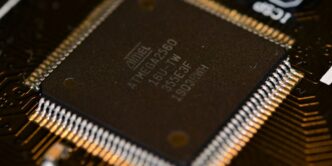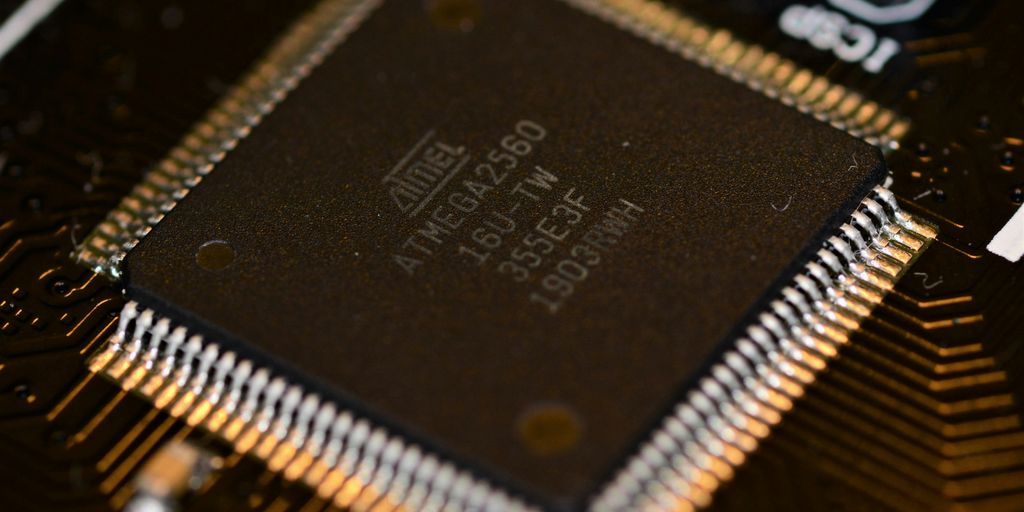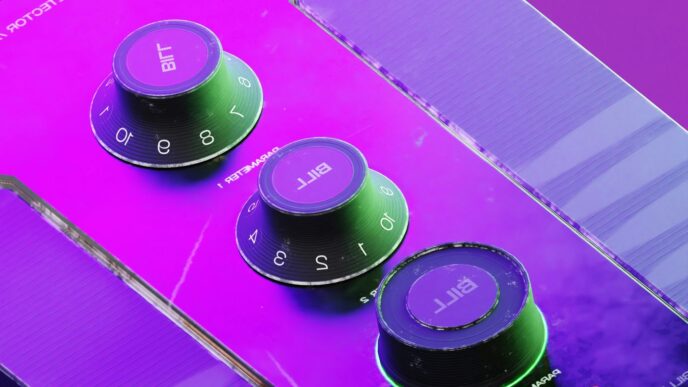It’s been a busy week for Intel, with quite a few big announcements shaking things up in the tech world. From government backing to shifts in the market and ambitious plans for the future, there’s a lot to unpack. Let’s get into the latest intel news and what it means for everyone.
Key Takeaways
- The U.S. government has acquired a nearly 10% stake in Intel, a move intended to boost its chip manufacturing business.
- Intel faces challenges with declining market share in CPUs and has been impacted by manufacturing delays, allowing competitors to gain ground.
- The company is pushing forward with major investments to expand its chipmaking capacity in the U.S., aiming to become a top foundry.
- Intel’s leadership is focused on financial improvements and has secured partnerships with major tech companies like Microsoft and Dell.
- The company must navigate geopolitical risks, technological hurdles, and increasing regulatory attention due to its government ties.
Intel Secures Government Stake Amidst Strategic Shift

It’s been a big week for Intel, and honestly, it’s kind of a wild turn of events. The U.S. government is now a shareholder, taking a 9.9% stake in the company. This whole deal is worth about $8.9 billion, which is coming from a mix of CHIPS Act grants and funds from something called the Secure Enclave program. Basically, the government is putting its money where its mouth is, showing confidence in Intel’s plans to ramp up chip manufacturing right here in the States.
U.S. Government Acquires 9.9% Stake in Intel
So, the U.S. government is buying a chunk of Intel, specifically 433.3 million shares at $20.47 each. This makes them a pretty significant owner, holding nearly 10% of the company. It’s a passive investment, meaning they won’t be sitting on the board or anything, but it’s still a major move. They’re even getting warrants for more shares down the line. This investment is on top of the grants Intel has already received, bringing the total government backing to over $11 billion. It’s a clear signal that the administration sees Intel as vital for national security and economic strength.
Deal Aims to Bolster Intel’s Foundry Business
Intel has been talking a big game about becoming a major player in the foundry business – that’s essentially contract chipmaking for other companies. They’ve got these massive expansion plans, especially in places like Arizona and Ohio, aiming to build out U.S. chipmaking capacity. This government investment is seen as a way to give Intel the financial boost and credibility it needs to really compete in this space. The goal is ambitious: to become the world’s second-largest foundry by 2030. It’s a tough market, though, with companies like TSMC already way ahead.
Concerns Raised Over Government-Private Sector Blurring
Now, not everyone is thrilled about this. Some folks are worried that this deal blurs the lines between the government and private companies. You hear concerns about potential conflicts of interest and whether this is a step towards government control of industry. Critics have pointed out that Intel has had a rough time lately, with manufacturing delays and losing market share to competitors like AMD. They question if customers will really trust Intel with their chip production, given its past performance. It’s a valid point – when the government gets too involved, things can get complicated, and it might not always lead to the best results for productivity or fair competition.
Intel’s Market Position and Competitive Landscape

It’s no secret that Intel has been facing some tough competition lately. For years, they were the undisputed king of making computer chips, especially for servers and personal computers. Back in 2016, they practically owned the market, handling almost all server CPU shipments and about 90% of PC CPU shipments. But things have changed. Competitors like AMD and those using Arm architecture have really stepped up their game.
This shift isn’t just a small blip. Intel’s share in the data center server CPU market has dropped to 63%, and in the PC market, it’s now at 66%. A big reason for this has been manufacturing delays, particularly with their 10-nanometer process technology, which caused a lot of setbacks between 2015 and 2020. This gave rivals, like Taiwan Semiconductor, a chance to pull ahead and become the leader in advanced chip manufacturing.
Here’s a quick look at how market share has shifted:
- Data Center Server CPUs: Intel’s share went from nearly 100% in 2016 to 63% recently.
- PC CPUs: Intel’s share decreased from around 90% in 2016 to 66%.
These changes have had a real impact. Intel’s financial results have taken a hit, with earnings per diluted share falling significantly. The company is now pouring billions into expanding its foundry business, aiming to catch up and even surpass competitors. It’s a big gamble, but they’re clearly trying to reclaim their former glory. The recent government investment is seen by some as a sign of confidence, but the road ahead is still challenging.
Intel’s Ambitious Foundry Expansion Plans
Intel is really going big on building more chip factories here in the U.S. They’re putting over $100 billion into expanding their sites across the country. The new factory they’ve got going up in Arizona is supposed to start making chips in large volumes later this year. It’s going to use the most advanced manufacturing tech available on American soil.
Since taking over as CEO back in March, Lip-Bu Tan has been making some big moves to get Intel’s finances in better shape and really focus on the engineering side of things. This new government deal is part of that bigger plan to set Intel up for the future.
It’s interesting because a lot of big tech companies are also backing President Trump’s push to make the U.S. a leader in technology and manufacturing. Intel is talking a lot with other companies and customers who also want to see a stronger, more reliable chip supply chain in the U.S.
For example, Microsoft’s CEO, Satya Nadella, mentioned that the long-standing partnership between Microsoft and Intel has led to some amazing technological advancements, calling it a showcase of American innovation. He thinks Intel’s continued investment in the U.S. chip supply chain, with the President’s support, will be good for the country and the whole tech world for years to come.
Similarly, Michael Dell from Dell Technologies said the industry really needs a strong U.S. chip industry, and Intel is key to that. He’s happy to see Intel and the current administration working together to boost U.S. technology and manufacturing, and Dell is all in on supporting these goals, looking forward to using Intel chips made in America for their next products.
Leadership Actions and Strategic Partnerships
Intel’s CEO, Pat Gelsinger, has been busy since taking the helm. He’s been making moves to get the company back on solid financial ground and really push that engineering focus again. A big part of this is the recent deal where the U.S. government is taking a 9.9% stake in the company. This isn’t just some small handshake deal; it’s a significant move aimed at boosting Intel’s foundry business, which is basically Intel making chips for other companies.
This government involvement has definitely got people talking. Some see it as a smart way to bring chip manufacturing back to the U.S. and create jobs, while others are a bit uneasy about the government getting so involved in a private company. It’s a bit of a blurring of lines, for sure.
CEO’s Swift Actions to Strengthen Financials
Since becoming CEO in March, Gelsinger has been pretty active. He’s been working to improve Intel’s financial health and get the company back to its roots of being an engineering powerhouse. This new government partnership is seen as a key part of that strategy to set Intel up for the future.
Collaboration with Tech Giants Like Microsoft and Dell
It’s not just the government that’s backing Intel. Big names in tech are also on board. Microsoft’s CEO, Satya Nadella, mentioned the long-standing partnership between Microsoft and Intel, saying Intel’s investment in the U.S. supply chain will benefit the whole tech world. Michael Dell from Dell Technologies echoed this, stating that Intel is vital for a strong U.S. chip industry and that Dell supports these efforts to advance American tech and manufacturing.
HP CEO Commends Intel’s Domestic Investment
Enrique Lores, the CEO of HP, also chimed in, expressing his support for Intel’s commitment to building up the U.S. semiconductor industry. He sees Intel’s continued investment in research and development and manufacturing right here in America as crucial for future innovation and strengthening the partnership between HP and Intel. He called it a "defining moment for great American companies."
Navigating Risks and Future Uncertainties
It’s not all smooth sailing for Intel, even with this new government backing. There are definitely some tricky waters ahead. For starters, geopolitical tensions are a big deal. Think about trade wars and conflicts in places like the Middle East or between China and Taiwan. These things can really mess with supply chains, which, as you know, are super complicated for chipmakers. Intel’s global network relies on a lot of different pieces, and any disruption, delay, or shortage can have a ripple effect.
Then there’s the whole race to develop new tech. It’s a constant battle to stay ahead, and making new products and manufacturing processes is incredibly complex and risky. You’re pouring a ton of money into research and development, and there’s no guarantee it’ll pay off. Plus, keeping up with the rapid pace of change in the semiconductor world is a challenge in itself. We’ve already seen how manufacturing delays have impacted their competitiveness.
And let’s not forget the legal and regulatory side of things. When you partner with the government, especially in this way, you get a lot more scrutiny. Intel has to make sure it’s playing by all the rules, which can be tough with evolving laws in different countries. There’s also the risk of litigation, whether it’s over intellectual property or other issues. Intel itself has pointed out that this government stake could potentially hurt its international sales and make it harder to get future grants. It’s a balancing act, for sure. The company needs to manage its debt, find capital, and keep its top people happy, all while dealing with these external pressures. It’s a lot to juggle, and investors are watching closely to see how they handle it all. You can read more about the potential impact of government stakes in companies like Intel here.
Financial Performance and Investor Outlook
Things have been a bit of a rollercoaster for Intel lately, and investors are watching closely. The company’s recent earnings per share have seen a dip, which isn’t exactly the kind of news folks want to hear, especially when the market itself is feeling a bit shaky. It’s tough out there, and Intel is definitely feeling the pressure.
Recent Decline in Earnings Per Share
Let’s get real, the numbers aren’t painting the prettiest picture right now. Intel’s earnings per share have taken a hit. This could be due to a bunch of things – maybe increased spending on those big expansion plans, or perhaps the ongoing competition is just biting harder than expected. Whatever the reason, it’s something that’s definitely on investors’ minds.
Stock Performance Amidst Market Challenges
When earnings go down, the stock price often follows, and Intel’s stock has been no exception. It’s been trading in a pretty choppy way, reacting to both company-specific news and the broader market mood. You see big swings, up and down, as people try to figure out where Intel fits in this fast-moving tech world. The recent government stake deal, while strategic, also adds a layer of complexity that the market is still trying to price in. It’s a lot to digest, and the stock reflects that uncertainty.
Analyst Expectations for Future Market Share
So, what do the experts think? Analysts are looking at Intel’s ambitious plans, like becoming the second-largest foundry, and trying to figure out if they can actually pull it off. They’re also weighing the risks – you know, things like manufacturing delays, intense competition from companies like AMD and Nvidia, and those big investments that might not pay off. Most agree that Intel has a long road ahead to regain significant market share, especially in the server and PC spaces. They’re hoping the new foundry strategy and partnerships will start to turn things around, but it’s going to take time and some serious execution.
Wrapping Up Today’s Intel News
So, that’s the latest from Intel. It’s been a busy period, especially with that big deal involving the U.S. government. While Intel is making some serious moves to ramp up its chip production here at home, there are definitely some questions being asked about how this government partnership will play out. It’s a complex situation, with potential upsides for domestic manufacturing but also some concerns about how it all works. We’ll have to keep an eye on how these plans unfold and what it means for the company and the wider tech world. Definitely a lot to watch in the coming months.
Frequently Asked Questions
Why did the U.S. government buy a stake in Intel?
The U.S. government has bought a nearly 10% piece of Intel. This move is meant to help Intel, the biggest chip maker in America, grow its business that makes chips for other companies. It’s also seen as a way to strengthen the country’s ability to make advanced technology.
What challenges has Intel been facing recently?
Intel has faced tough times lately. Its market share for computer chips has dropped because of problems with making chips on schedule and because competitors have made better products. This deal gives Intel some much-needed money and support.
What are Intel’s plans for building more factories?
Intel is investing a lot of money, over $100 billion, to build more chip factories in the U.S., especially in Arizona and Ohio. Their goal is to become the second-largest company that makes chips for others by the year 2030.
Are there any concerns about this government deal?
Some people worry that when the government owns a part of a company, it blurs the lines between government and private business. They are concerned this could lead to unfair advantages or influence on business decisions.
Who are Intel’s key partners in this effort?
Intel is working with big tech companies like Microsoft and Dell. These companies see Intel’s investment in U.S. chip making as important for future technology and a strong partnership.
What are the main risks Intel faces going forward?
Intel faces challenges like global competition, the need to create new and better chip technologies, and navigating rules and laws that come with government partnerships. World events and trade issues can also affect their supply chain.














